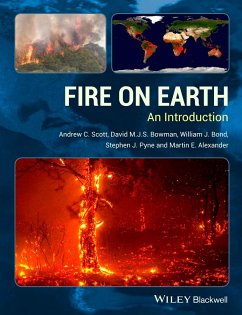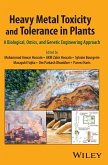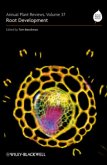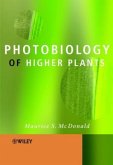Earth is the only planet known to have fire. The reason is both simple and profound: fire exists because Earth is the only planet to possess life as we know it. Fire is an expression of life on Earth and an index of life's history. Few processes are as integral, unique, or ancient.
Fire on Earth puts fire in its rightful place as an integral part of the study of geology, biology, human history, physics, and global chemistry. Fire is ubiquitous in various forms throughout Earth, and belongs as part of formal inquiries about our world. In recent years fire literature has multiplied exponentially; dedicated journals exist and half a dozen international conferences are held annually. A host of formal sciences, or programs announcing interdisciplinary intentions, are willing to consider fire. Wildfire also appears routinely in media reporting.
This full-colour text, containing over 250 illustrations of fire in all contexts, is designed to provide a synthesis of contemporary thinking; bringing together the most powerful concepts and disciplinary voices to examine, in an international setting, why planetary fire exists, how it works, and why it looks the way it does today. Students, lecturers, researchers and professionals interested in the physical, ecological and historical characteristics of fire will find this book, and accompanying web-based material, essential reading for undergraduate and postgraduate courses in all related disciplines, for general interest and for providing an interdisciplinary foundation for further study.
A comprehensive approach to the history, behaviour and ecological effects of fire on earth
Timely introduction to this important subject, with relevance for global climate change, biodiversity loss and the evolution of human culture.
Provides a foundation for the interdisciplinary field of Fire Research
Authored by an international team of leading experts in the field
Associated website provides additional resources
Hinweis: Dieser Artikel kann nur an eine deutsche Lieferadresse ausgeliefert werden.
Fire on Earth puts fire in its rightful place as an integral part of the study of geology, biology, human history, physics, and global chemistry. Fire is ubiquitous in various forms throughout Earth, and belongs as part of formal inquiries about our world. In recent years fire literature has multiplied exponentially; dedicated journals exist and half a dozen international conferences are held annually. A host of formal sciences, or programs announcing interdisciplinary intentions, are willing to consider fire. Wildfire also appears routinely in media reporting.
This full-colour text, containing over 250 illustrations of fire in all contexts, is designed to provide a synthesis of contemporary thinking; bringing together the most powerful concepts and disciplinary voices to examine, in an international setting, why planetary fire exists, how it works, and why it looks the way it does today. Students, lecturers, researchers and professionals interested in the physical, ecological and historical characteristics of fire will find this book, and accompanying web-based material, essential reading for undergraduate and postgraduate courses in all related disciplines, for general interest and for providing an interdisciplinary foundation for further study.
A comprehensive approach to the history, behaviour and ecological effects of fire on earth
Timely introduction to this important subject, with relevance for global climate change, biodiversity loss and the evolution of human culture.
Provides a foundation for the interdisciplinary field of Fire Research
Authored by an international team of leading experts in the field
Associated website provides additional resources
Hinweis: Dieser Artikel kann nur an eine deutsche Lieferadresse ausgeliefert werden.
"The well-organized and illustrated work can be used as a textbook or a reference source for practitioners. Each chapter has a list of further readings, and each part has its own extensive bibliography. This phenomenal contribution will become a classic reference for five mangers, students of fire ecology and climate, and researchers for years to come. Summing Up: Essential. All levels/libraries." (Choice, 1 October 2014)
"Overall, the book provides an excellent, multidisciplinary introduction to fire, authored by leading experts in their fields, written in a very accessible style and supported by superb illustrations and extensive references. Hence, I highly recommend it to potential readers, who may be upper level undergraduate students, graduate students, teaching staff and everyone working, or simply interested, in the area of environmental science." (International Journal of Wildland Fire, 1 August 2014)
"Fire and earth scientists, anthropologists, ecologists, resource managers, and especially advanced students in natural sciences will find the text, along with its online resources, a requisite addition to their libraries. Not only is it a pleasure to read, simply put, it sparks the imagination." (Fire Ecology, 1 June 2014)
"With wildfire recognised in key government contingency documents, not least for climate change, foresters looking for greater understanding of this future challenge over the coming decades, should look no further." (Chartered Forester, 1 May 2014)
"This book is a good example of a multidisciplinary investigation. The writers express the wish that it may stimulate further research into fire processes, both 'natural' and induced by humanity. A book worth reading!." (Geological Journal, 29 April 2014)
"Overall, the book provides an excellent, multidisciplinary introduction to fire, authored by leading experts in their fields, written in a very accessible style and supported by superb illustrations and extensive references. Hence, I highly recommend it to potential readers, who may be upper level undergraduate students, graduate students, teaching staff and everyone working, or simply interested, in the area of environmental science." (International Journal of Wildland Fire, 1 August 2014)
"Fire and earth scientists, anthropologists, ecologists, resource managers, and especially advanced students in natural sciences will find the text, along with its online resources, a requisite addition to their libraries. Not only is it a pleasure to read, simply put, it sparks the imagination." (Fire Ecology, 1 June 2014)
"With wildfire recognised in key government contingency documents, not least for climate change, foresters looking for greater understanding of this future challenge over the coming decades, should look no further." (Chartered Forester, 1 May 2014)
"This book is a good example of a multidisciplinary investigation. The writers express the wish that it may stimulate further research into fire processes, both 'natural' and induced by humanity. A book worth reading!." (Geological Journal, 29 April 2014)








